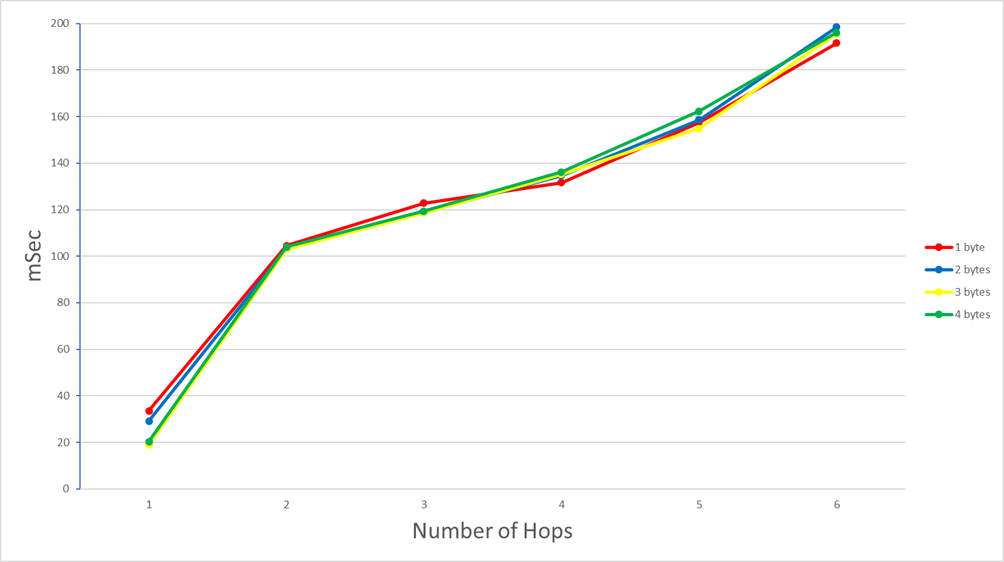SWRA732 December 2021 CC1352P , CC1352R , CC1354P10 , CC1354R10 , CC2642R , CC2652R , CC2652R7 , CC2652RSIP
6.2 Software Setup
Source and destination nodes were configured as mesh nodes using a network processor solution, leveraging ERPC and our mesh_app_python example to control these nodes using Python [10] on a Windows PC.
The other relay nodes in the network in this test are strictly embedded nodes without network processor support.
Mesh network payloads were sent from the source node to the destination node with the following configuration:
| Configuration | Value |
|---|---|
| Data Size | 1, 2, 3, 4 byte(s) |
| Message Type | Unsegmented |
| # Messages | 100 |
| ADV interval | 10 ms |
| Scan interval | 20 ms |
| Net transmit | 1 |
| Net transmit interval | 10 ms |
| Relay retransmit | 3 |
| Relay retransmit interval | 10 ms |
The following are the latency results for the above configuration, including the time in milliseconds it took to deliver the message from source to destination node across each hop. The percentage of messages received is also recorded across each hop.
 Figure 6-2 Message Latency (ms) Across
Multiple Hops (3 Retransmissions)
Figure 6-2 Message Latency (ms) Across
Multiple Hops (3 Retransmissions)Table 6-2 summarizes the data presented above, measured on a 6-node network with variable unsegmented payload sizes, up to 3 retransmissions allowed, and a 10ms advertisement interval.
| Hop | 1 byte | 2 bytes | 3 bytes | 4 bytes | ||||
|---|---|---|---|---|---|---|---|---|
| E2E delay (ms) | PER (%) | E2E delay (ms) | PER (%) | E2E delay (ms) | PER (%) | E2E delay (ms) | PER (%) | |
| 1 | 33.48 | <3 | 29.16 | <3 | 18.96 | <5 | 20.28 | <10 |
| 2 | 104.51 | <5 | 103.19 | <3 | 102.96 | <3 | 103.94 | <3 |
| 3 | 122.88 | <3 | 118.77 | <10 | 118.66 | <3 | 119.41 | <5 |
| 4 | 131.57 | <5 | 134.60 | <5 | 135.25 | <3 | 136.13 | <3 |
| 5 | 157.44 | <5 | 158.63 | <3 | 154.85 | <5 | 162.25 | <5 |
| 6 | 191.67 | <5 | 198.51 | <3 | 195.64 | <3 | 196.11 | <10 |
Bluetooth Mesh allows mesh nodes to retransmit messages to increase the reliability and robustness of a mesh network. The tests performed above allowed three retransmissions, resulting in a very low packet error rate. An average PER of 3% was seen across each hop and for all payload sizes listed in the table above. However, low PER comes at the cost of additional latency to transmit the additional messages. This is an example of one of the many tradeoffs to be considered when designing a mesh network. With proper network deployment, application design, and configuration of relevant parameters of the protocol stack, Bluetooth mesh is able to support the operation of dense networks with tens to hundreds of devices.